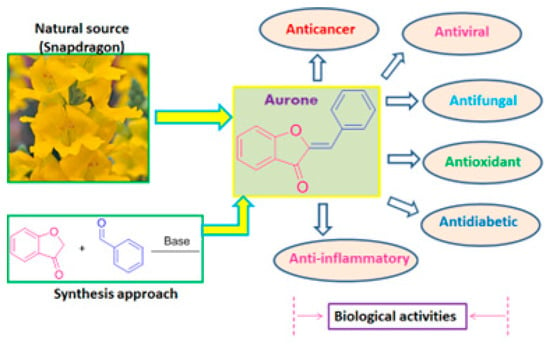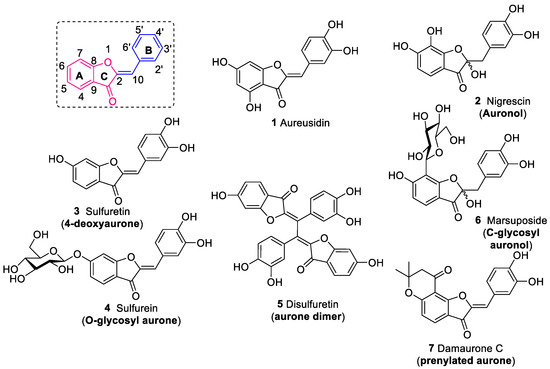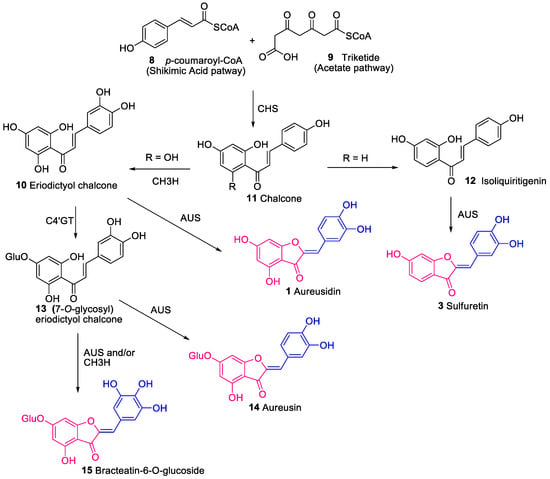Natural products are a boundless source for the development of pharmaceutical agents against a wide range of human diseases. Accordingly, naturally occurring aurones possess various biological benefits, such as anticancer, antioxidant, antimicrobial, antidiabetic, anti-inflammatory, antiviral and neuroprotective effects. In addition, various studies have revealed that aurones are potential templates for the regulation of diabetes mellitus and its associated complications. Likewise, certain aurones and their analogues have been found to be remarkable kinase inhibitors of DARK2, PPAR-γ, PTPM1, AGE, α-amylase and α-glucosidase, which represents a promising approach for the treatment of chronic metabolic disorders such as diabetes.
1. Introduction
Among the world’s fastest-growing non-communicable diseases, diabetic mellitus (DM) is the foremost chronic metabolic disorder, threatening people’s lives and resulting in economic burden. According to a study by the International Diabetic Federation (IDF), approximately 552 million people might be suffering from diabetes worldwide by the year 2030 [
1,
2]. Blood glucose intolerance is the main reason for the chronic metabolic disorder called “diabetic mellitus”. The disorder can be classified into three categories: type-I DM is due to insufficient insulin secretion triggered by mechanical failure of the pancreas, and type-II DM occurs due to insulin resistance. Gestational and neonatal diabetes belong to the third category of DM [
3,
4]. In general, type-II DM is very common, and it is induced by lifestyle habits and hereditary factors [
5]. Currently, various types of drugs, such as sulfonylureas, biguanides, thiazolidinediones, α-glucosidase inhibitors, meglitinides, GLP-1 mimetics, DPP-IV inhibitors, SGLT2 inhibitors, etc., are available to treat diabetes and associated mechanisms [
6]. However, medicines currently in use have various moderate to lethal adverse effects, such as dehydration, diarrhea, constipation, bloating, nausea, gastrointestinal problems, kidney disease, respiratory tract infections, coronary artery diseases (CAD), dermatological problems, and injection site infections, etc. In addition, the number of people being diagnosed with diabetes is also increasing massively. Therefore, new therapeutic approaches and amplified drugs are needed to tackle this complex-patterned metabolic disorder.
In this regard, natural products are a prominent resource for modern drug discovery, having already provided a range of therapeutic drugs [
7,
8]. For instance, broad-spectrum antibiotics such as
β-lactam, tetracycline, ciprofloxacin and erythromycin are still important clinical drugs of choice for various diseases today [
9,
10]. In addition, people are now aware of the role of natural antioxidants in the prevention of various non-communicable diseases and of their health promoting benefits [
11,
12]. Therefore, fruits and food beverages that are richer in polyphenolics such as anthocyanins, catechins, phenolic acids, flavonoids, stilbenes and resveratrols have strategic key roles in health promotion and disease prevention [
12,
13,
14].
Interestingly, aurones [2-benzylidenebenzofuran-3(2
H)-ones] are naturally occurring five-membered flavonoids with benzofuran class heterocycles having benzylidene moiety at C-2. In the last decade, they have been recognized as a template for diverse pharmacological activities (
Figure 1), such as antioxidant, antimicrobial, antimalarial, antitumor, antidiabetic and neuroprotective capabilities [
15]. Moreover, a recent study also summarized the potential for using aurone scaffolds as markers in the preventive and therapeutic mechanisms of various cancers [
16]. Accordingly, aurone scaffolds exhibit a wide range of anticancer properties through various modes of action, such as adenosine receptor, cyclic dependent kinase, DNA scissoring, histone deacetylase, sirtuins, topoisomerase, tubulin, tyrosinase, TNFα, PEG2 and nitric oxide inhibitory mechanisms. However, there have been no significant comprehensive studies on the antidiabetic potentialities of aurones.
Figure 1. Schematic representation of the source of aurones and their biological importance.
2. Occurrence and Distribution of Aurones
Aurones are the essential plant secondary metabolites of biologically stimulating natural products and are widely distributed in the flowers and fruits of various plants species. In addition to plant sources, aurones are also distributed in certain brown algae, bryophytes and gymnosperms class species [
17,
18]. Indeed, aurones occur in minute concentrations in natural sources and are therefore described as minor flavonoids that are not yet well explored. Principally, aurones act as a coloring agent, giving bright and attractive colors to flowers such as cosmos, snapdragons and some ornamental plants, etc. Therefore, aurones also play an important role in pollination, which gives them an essential role in crop production from an agricultural point of view [
19]. Aurones are distributed in a limited number of genera, such as
Asteraceae,
Anacardiaceae,
Cactaceae,
Cyperaceae,
Fabaceae,
Gesneriaceae,
Oxalidaceae,
Moraceae,
Plumbaginaceae,
Rhamnaceae,
Rosaceae,
Rubiaceae and
Scrophulariaceae, etc. [
18,
20]. Also, depending on their taxonomic importance in the plant kingdom, aurones may have various skeletal substitution patterns, as shown in
Figure 2. Principally, aurones can be classified as 4-hydroxyaurones, 4-deoxyaurones, penylated aurones, glycosylated aurones, epimeric mixtures (aurones in bimers or trimers), etc. Interestingly, the
Asteraceae species is rich in 4-deoxyaurones, for instance Sulfuretin, Sulfurein, Maritimetin, Maritimein, Leptosidin and Leptosin, etc. [
18,
21]. In addition, the flowers of the
Asteraceae species are rich in aurone glycosides such as di-glucosides and acetylated aurone glucosides. In particular, the aurones isolated from the sunflower family or the
Bidens genus interestingly showed hydroxylation in the 6-position (ring A) and the 3- and 4-positions (in ring B), but not in the 4-position of the aurone skeleton [
20]. Moreover, the
Moraceae species was rich in structurally distinct auronols, prenylated and geranylated aurones [
22]. Interestingly, various aurone dimers such as flavanone-auronol, isoflavanone-auronol, deoxyauronol-auronol, auronol-auronol (biauronols) and other epimeric mixtures from the plant species
Anacardiaceae and
Rhamnaceae have also been reported [
20]. Moreover, the 4-, 6-hydroxyl substitutions in the ring-A and the 4′, 3′-hydroxyl substitutions in the ring-B of aroune are most common and are related with the biosynthetic pathways. However, the skeletal substitutions of aurones depended on the biochemical reactions connected in the biosynthesis of aurones [
23], which might vary by family and tropical subcontinent depending on seasonal temperatures.
Figure 2. Common numbering of aurone rings and some interesting natural examples. Pink color represents benzofuran moiety and blue color represents benzylidene moiety.
3. Biosynthesis of Aurones
The occurrences of secondary metabolites, for example, polyphenols, alkaloids, terpenoids, steroids, polyketides, and so on are common in the plant kingdom. In particular, secondary metabolites which are produced in plants have diverse functions such as photoprotection, enzyme modulation, defense against pathogen invasion, reproductive persistence, symbiosis and other growth-regulating defenses mechanisms. However, polyphenols represent the largest family of plant secondary metabolites formed via biogenesis pathways and are generally involved in protection against disease mechanisms and photoprotection. The biosynthesis or biogenesis of aurones in plant kingdom can be comprehensively classified into two steps: the primary step involves the synthesis of 2′-hydroxychalcones from coumaryl-CoA, and the second step involves hydroxylation and oxidative cyclization of hydroxychalcones [
24,
25,
26]. The biogenesis of chalcones was catalyzed by chalcone synthase (CHS) via the reaction between the acetate and shikimic acid, which has been well described in several reports [
27,
28]. Therefore, this part discusses the biosynthesis of aurones from chalcones in the following mechanisms as described in
Figure 3. Principally, aurone biosynthesis was catalyzed by two important enzymes such as chalcone hydroxylase (CHH) and aurone synthase (AUS) [
24,
25]. The homolog of plant polyphenol oxidase (PPO), chalcone 3-hydroxylase (CH3H) enzyme, catalyzes the addition of hydroxyl groups to the
ortho-position to the existing hydroxyl group on ring-B, through oxidation prototyping [
21]. Likewise, the second enzyme aurone synthase (AUS) plays a crucial role in the cyclization to form benzofuran skeleton [
25], while the other enzyme chalcone 4′-glucosyl transferase (C4′GT) effectively catalyzes in the formation of glycosylated aurones in the plant kingdom. Therefore, the PPO plays a key role in the oxidation and existence of diverse substitutional pattern of aurones in plant sources.
Figure 3. The biosynthetic approach of aurones from chalcones. Pink color represents benzofuran moiety and blue color represents benzylidene moiety.
This entry is adapted from the peer-reviewed paper 10.3390/cimb45100533



